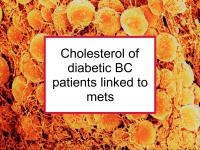Type 2 diabetes has been shown to increase breast cancer risk and worsen prognosis. The picture is less clear for high cholesterol. total cholesterol consists primarily of high-density lipoprotein (HDL, the "good" cholesterol), low-density lipoprotein (LDL, the "bad" cholesterol), and triglycerides.
Use of statins to treat high cholesterol has been shown to lessen breast cancer rates in some women. However, statin use appears to influence breast cancer risk and survival inconsistently, according to available research, indicating that individual genetic makeup and other personal characteristics could also play a role. Now a new study has reported that HDL from breast cancer patients with type 2 diabetes promotes one of the first steps in metastasis.
High cholesterol and breast cancer risk & metastasis
Cholesterol is a waxy, fat-like substance found throughout the body, including the blood. There is evidence that a poor cholesterol profile can accelerate breast tumor formation and growth. Breast cells have the propensity to accumulate cholesterol.
Normal breast cells respond to oxidized LDL by increasing proliferative and pro-inflammatory signaling, thereby setting the stage for breast cancer development. Tamoxifen works, in part, by reducing cholesterol.
Dietary cholesterol has been shown to promote and accelerate mammary tumor formation in mice. Mice fed a high cholesterol diet in one study developed larger tumors that were faster growing and metastasized more easily compared to mice on a control diet.
Population studies have also found a link between high cholesterol and increased breast cancer risk. Unfortunately, high levels HDL as well as LDL have been found to be associated with increased breast cancer risk.
Blood cholesterol levels are reduced during tumor development because of increased use of cholesterol by tumors. In fact, there is evidence that low cholesterol is also associated with breast cancer, possibly because undiagnosed tumors are already using cholesterol.
Diabetic HDL facilitates circulating tumor cell adhesion
The authors of the study referenced at the beginning of this news story previously demonstrated that HDL from patients with type 2 diabetes can promote breast cancer metastasis.
The current study extends this work by investigating the role of diabetic HDL cholesterol in enabling the adhesion of circulating tumor cells to the endothelium, which lines the interior surface of blood vessels.
Circulating tumor cells are believed to be responsible for the dissemination of cancer from a primary tumor to distant organs. Once a tumor cell enters the bloodstream, it must survive the shear stresses due to fluid flow before moving out of circulation into a secondary tumor site. Adhesion of such tumor cells to the vascular endothelium is a necessary step in this metastasis cascade.
To conduct the study, the authors examined the role of ICAM-1 (intercellular adhesion molecule 1) and VCAM-1 (vascular cell adhesion molecule 1) in the circulating tumor cell adhesion process. Triple negative (MDA-MB-231) and ER+/PR+ (MCF-7) breast cancer cells, as well as human umbilical vein endothelial cells (HUVECs) were treated with either "normal" HDL (N-HDL) from healthy controls, HDL from breast cancer patients (B-HDL), or HDL from breast cancer patients with type 2 diabetes (BD-HDL). The adhesion abilities of each cell type treated with each HDL type were assessed.
BD-HDL was found to promote an increase in breast cancer cell adhesion to HUVECs. BD-HDL also stimulated higher ICAM-1 and VCAM-1 expression on the cell surfaces of both breast cancer and HUVEC cells. Increased tumor cell adhesion and ICAM-1 and VCAM-1 expression induced by BD-HDL was able to be inhibited by the relevant enzyme inhibitor. The authors also found that vascular endothelium adhesion was greater in a mouse model of type 2 diabetes compared to normal mice.
The authors conclude that HDL from breast cancer patients with type 2 diabetes facilitates the adhesion of tumor cells to vascular endothelium by upregulating the expression of ICAM-1 and VCAM-1, thereby promoting the initial progression of breast cancer metastasis. This indicates that HDL-based strategies could be useful in treating breast cancer patients with type 2 diabetes.
Please see our article on type 2 diabetes for more information.
